
Waste management or waste disposal includes the processes and actions required to manage waste from its inception to its final disposal. This includes the collection, transport, treatment, and disposal of waste, together with monitoring and regulation of the waste management process and waste-related laws, technologies, and economic mechanisms.
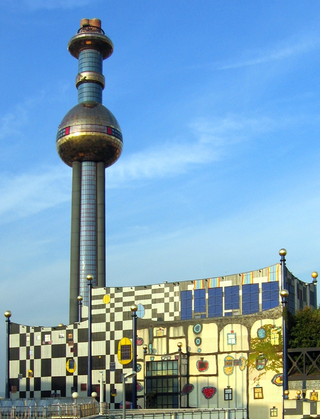
Incineration is a waste treatment process that involves the combustion of substances contained in waste materials. Industrial plants for waste incineration are commonly referred to as waste-to-energy facilities. Incineration and other high-temperature waste treatment systems are described as "thermal treatment". Incineration of waste materials converts the waste into ash, flue gas and heat. The ash is mostly formed by the inorganic constituents of the waste and may take the form of solid lumps or particulates carried by the flue gas. The flue gases must be cleaned of gaseous and particulate pollutants before they are dispersed into the atmosphere. In some cases, the heat that is generated by incineration can be used to generate electric power.
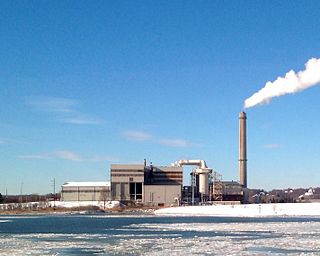
A waste-to-energy plant is a waste management facility that combusts wastes to produce electricity. This type of power plant is sometimes called a trash-to-energy, municipal waste incineration, energy recovery, or resource recovery plant.
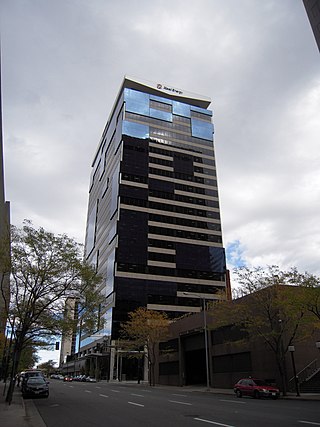
Xcel Energy Inc. is a U.S. regulated electric utility and natural gas delivery company based in Minneapolis, Minnesota, serving more than 3.7 million electric customers and 2.1 million natural gas customers across parts of eight states. It consists of four operating subsidiaries: Northern States Power-Minnesota, Northern States Power-Wisconsin, Public Service Company of Colorado, and Southwestern Public Service Co.

Waste-to-energy (WtE) or energy-from-waste (EfW) refers to a series of processes designed to convert waste materials into usable forms of energy, typically electricity or heat. As a form of energy recovery, WtE plays a crucial role in both waste management and sustainable energy production by reducing the volume of waste in landfills and providing an alternative energy source.
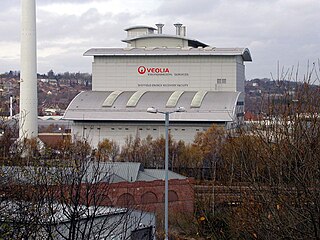
The Sheffield Energy Recovery Facility, also known as the Energy from Waste Plant, is a modern incinerator which treats Sheffield's household waste. It is notable as it not only provides electricity from the combustion of waste but also supplies heat to a local district heating scheme, making it one of the most advanced, energy efficient incineration plants in the UK. In 2004, the district heating network prevented 15,108 tonnes of CO2 from being released from buildings across the city, compared to energy derived from fossil fuels. The incinerator is a 'static asset' owned by Sheffield City Council and operated by Veolia Environmental Services under a 35 year integrated waste management contract (IWMC)/PFI contract.

South East London Combined Heat and Power, better known as SELCHP, is a major energy from waste incineration plant in Bermondsey, London. It was designed to generate both heat and electricity. The plant can generate up to 35 MegaWatts of power using a steam turbine in electricity only mode. It can incinerate up to 420,000 tonnes per year of municipal solid waste.

EcoPark is a waste-to-energy plant which burns waste from several London boroughs to provide electricity for the National Grid. It is located on the River Lee Navigation and bordered by the North Circular Road, in Edmonton in the London Borough of Enfield. It is also known as Edmonton EcoPark.

The Dickerson Generating Station is an 853 MW electric generating plant owned by NRG Energy, located approximately two miles west of Dickerson, Maryland, on the eastern banks of the Potomac River.

Reworld, formerly Covanta, is a private energy-from-waste and industrial waste management services company headquartered in Morristown, New Jersey. Most of its revenue comes from operating incineration facilities that serve a secondary purpose as power plants that burn trash as fuel. Reworld charges a fee for waste disposal and sells the electricity and metal slag produced from waste incineration.
Waste management in Japan today emphasizes not just the efficient and sanitary collection of waste, but also reduction in waste produced and recycling of waste when possible. This has been influenced by its history, particularly periods of significant economic expansion, as well as its geography as a mountainous country with limited space for landfills. Important forms of waste disposal include incineration, recycling and, to a smaller extent, landfills and land reclamation. Although Japan has made progress since the 1990s in reducing waste produced and encouraging recycling, there is still further progress to be made in reducing reliance on incinerators and the garbage sent to landfills. Challenges also exist in the processing of electronic waste and debris left after natural disasters.

Teesside Energy from Waste plant is a municipal waste incinerator and waste-to-energy power station, which provides 29.2 megawatts (MW) of electricity for the National Grid by burning 390,000 tonnes of household and commercial waste a year. It is located on the River Tees at Haverton Hill, east of Billingham in North East England. Developed and built by NEM, a subsidiary of Northumbrian Water, the initial plant replaced the Portrack Incinerator and opened in 1998. Subsequently, the facility became part of SITA, now Suez.

The "Naples waste management crisis" is a series of events surrounding the lack of waste collection and illegal toxic waste dumping in and around the Province of Naples, Campania, Italy, beginning in the 1980s. In 1994, Campania formally declared a state of emergency, ending in 2008, however, the crisis has had negative effects on the environment and on human health, specifically in an area that became known as the triangle of death. Due to the burning of accumulated toxic wastes in overfilled landfills and the streets, Naples's surrounding areas became known as the "Land of pyres". The crisis is largely attributed to government failure to efficiently waste manage, as well as the illegal waste disposal by the Camorra criminal organization.

Mark Charles Andrew is an American businessman and politician from Minneapolis, Minnesota. He is a member of the Democratic-Farmer-Labor party and has served as Hennepin County Commissioner, representing the western portion of Minneapolis and St. Louis Park, as well as chair of the Hennepin County Board of Commissioners. He also served as chair of the Democratic-Farmer-Labor party in 1995–1996. In 2007, Andrew founded GreenMark, an environmental marketing firm. In February 2013, Andrew announced his candidacy for mayor in the 2013 Minneapolis mayoral election.
The Essex County Resource Recovery Facility, also known as Covanta Essex, is a waste-to-energy incineration power station in Essex County, New Jersey, United States. Opened in 1990, it is owned by the Port Authority of New York and New Jersey (PANYNJ) and operated by Reworld. It is located adjacent to the New Jersey Turnpike between Raymond Boulevard and the Passaic River in Newark.
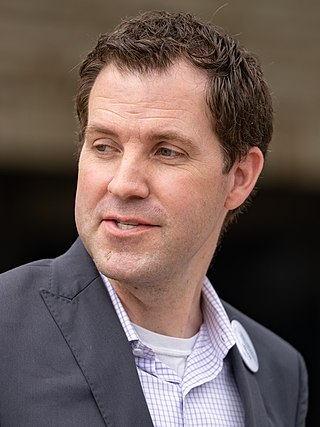
Jamie Long is an American politician serving in the Minnesota House of Representatives since 2019. A member of the Minnesota Democratic–Farmer–Labor Party (DFL), Long represents District 61B, which includes parts of southern Minneapolis in Hennepin County, Minnesota.

The Miaoli County Refuse Incineration Plant is an incinerator in Zhunan Township, Miaoli County, Taiwan. As of December 2019, monthly the incinerator received about 14,260 tons of waste and 14,316 tons of them was incinerated. The plant produced 8.193 GWh of electricity and 83.79% of it was sold to Taipower. It produced 2,454 tones of ashes.

New York City's waste management system is a refuse removal system primarily run by the New York City Department of Sanitation (DSNY). The department maintains the waste collection infrastructure and hires public and private contractors who remove the city's waste. For the city's population of more than eight million, The DSNY collects approximately eleven thousand tons a day of garbage, including compostable material and recycling.

The Delaware Valley Resource Recovery Facility is a trash incineration plant located in Chester, Pennsylvania. The waste-to-energy plant, which incinerates waste to generate power, was built and operated by Westinghouse from 1991 to 1997. It is currently operated by Reworld. a Morristown, New Jersey–based publicly traded industrial waste company, and has been criticized for the level of pollution it produces. The plant has the largest capacity of any waste-to-energy plant in the United States.
Istanbul Waste Power Plant is a waste-to-energy facility in the Eyüp district of Istanbul near the Odayeri landfill, Turkey, using waste incineration. Opened in 2021 it is owned by the Istanbul Metropolitan Municipality (İBB) and operated by İstanbul Environmental Management Co. (İSTAÇ). It is Turkey's first power plant of this type. Project development started in 2011 with a grant from the United States Trade Development Agency (USTDA) which involved first a Definitional Mission and subsequently a detailed Feasibility Assessment.


















